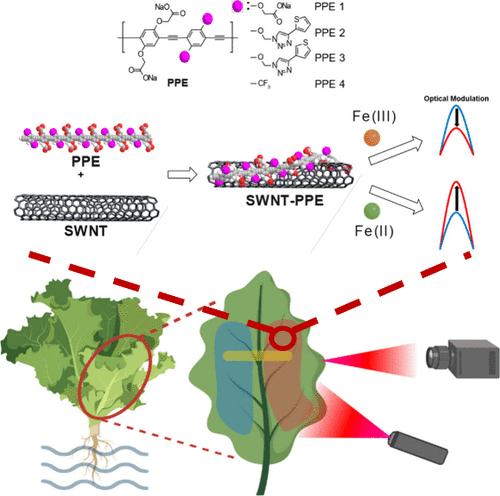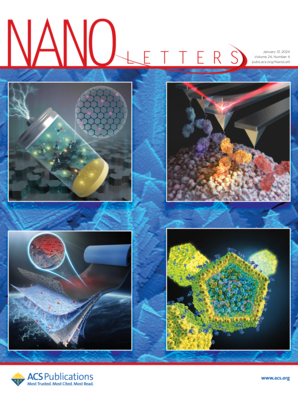Nanosensor for Fe(II) and Fe(III) Allowing Spatiotemporal Sensing in Planta
IF 9.6
1区 材料科学
Q1 CHEMISTRY, MULTIDISCIPLINARY
引用次数: 0
Abstract
Fluorescent nanosensors operating in planta have shown recent success toward informing basic plant biology and agricultural applications. We developed near-infrared (NIR) fluorescent nanosensors using the Corona Phase Molecular Recognition (CoPhMoRe) technique that distinguish Fe(II) and Fe(III) species with limit of detection as low as 10 nM. An anionic poly(p-phenyleneethynylene) (PPE) polyelectrolyte wrapped single-walled carbon nanotube (SWNT) shows up to 200% turn-on and 85% turn-off responses to Fe(II) and Fe(III), respectively, allowing spatial and temporal analysis of iron uptake in both foliar and root-to-shoot pathways. Our findings reveal species-dependent iron uptake efficiency, mobility, and utilization rates, which we show is primarily affected by the chelation status of iron source and by plant physiological conditions such as iron deficiency and treatment with the stress hormone, abscisic acid (ABA). The broad applicability of this sensor across important plant species highlights the potential of nanotechnology-enabled sensors to enable precise and sustainable nutrient management.

求助全文
约1分钟内获得全文
求助全文
来源期刊

Nano Letters
工程技术-材料科学:综合
CiteScore
16.80
自引率
2.80%
发文量
1182
审稿时长
1.4 months
期刊介绍:
Nano Letters serves as a dynamic platform for promptly disseminating original results in fundamental, applied, and emerging research across all facets of nanoscience and nanotechnology. A pivotal criterion for inclusion within Nano Letters is the convergence of at least two different areas or disciplines, ensuring a rich interdisciplinary scope. The journal is dedicated to fostering exploration in diverse areas, including:
- Experimental and theoretical findings on physical, chemical, and biological phenomena at the nanoscale
- Synthesis, characterization, and processing of organic, inorganic, polymer, and hybrid nanomaterials through physical, chemical, and biological methodologies
- Modeling and simulation of synthetic, assembly, and interaction processes
- Realization of integrated nanostructures and nano-engineered devices exhibiting advanced performance
- Applications of nanoscale materials in living and environmental systems
Nano Letters is committed to advancing and showcasing groundbreaking research that intersects various domains, fostering innovation and collaboration in the ever-evolving field of nanoscience and nanotechnology.
 求助内容:
求助内容: 应助结果提醒方式:
应助结果提醒方式:


